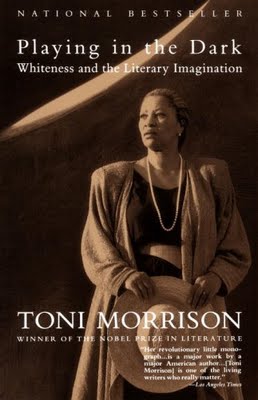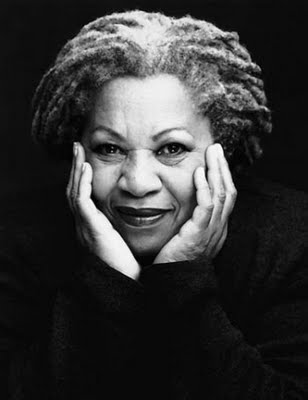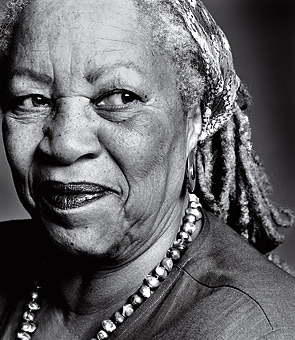This content is being reviewed in light of recent changes to federal guidance.
Playing in the Sunlight: Colors of Imagination, or Toni Morrison Revisited
 Having made proposals about the continual and continuous Africanist presence in the American literary imagination, Toni Morrison positions herself to be questioned about the invisible presence of an other, neither black nor white, which does or should haunt the American use of language. Should the case be otherwise, it would have to be claimed that the truly invisible other has been so thoroughly erased in historical consciousness and printed text as to be of minuscule importance. Morrison’s translation of her 1990 Massey lectures as Playing in the Dark: Whiteness and the Literary Imagination raises serious questions about the “inadequacy and the force of the imaginative act,” particularly when that phrase is juxtaposed with the amazing utterance “How compelling is the study of those writers who take responsibility for all of the values they bring to their art” (xiii). One of Morrison’s most valuable points in the book concerns the debatable validity of certain constructions of knowledge. It is an invitation to ask about her own constructions, in light of her disclaimer that she does not bring to the critical project “even principally the tools of a literary critic.” Do the tools of the literary artist suffice? And in this instance, might we think (with a tinge of perversity) that failure would be more valuable than success in helping us to understand Morrison as novelist/critic?
Having made proposals about the continual and continuous Africanist presence in the American literary imagination, Toni Morrison positions herself to be questioned about the invisible presence of an other, neither black nor white, which does or should haunt the American use of language. Should the case be otherwise, it would have to be claimed that the truly invisible other has been so thoroughly erased in historical consciousness and printed text as to be of minuscule importance. Morrison’s translation of her 1990 Massey lectures as Playing in the Dark: Whiteness and the Literary Imagination raises serious questions about the “inadequacy and the force of the imaginative act,” particularly when that phrase is juxtaposed with the amazing utterance “How compelling is the study of those writers who take responsibility for all of the values they bring to their art” (xiii). One of Morrison’s most valuable points in the book concerns the debatable validity of certain constructions of knowledge. It is an invitation to ask about her own constructions, in light of her disclaimer that she does not bring to the critical project “even principally the tools of a literary critic.” Do the tools of the literary artist suffice? And in this instance, might we think (with a tinge of perversity) that failure would be more valuable than success in helping us to understand Morrison as novelist/critic?
One feature of Morrison’s prose style and style of thought might serve to open an investigation. Consider these formations from pages 8 to 10 in Playing in the Dark:
- have disguised themselves and, in so doing, impoverished the literature
- its own implicit and explicit ideology
- that becomes and remains par of and significant within
- the deliberations of literary criticism and the wanton, elaborate strategies
- What Africanism became for, and how it functioned in, the literary imagination
- the invention and development of whiteness
- this large and compelling subject
- in matters of race, silence and evasion
- instinct argues against noticing and forecloses adult discourse
- literary and scholarly moeurs
- terminated the shelf life of some once extremely well-regarded American authors and blocked access
 The singular feature of the formations is yoking, the joining by use of the conjunction and. If one isolated and for notice in reading Playing in the Dark, its use might seem excessive. What does such highlighting of the possibility of joining at the syntactic level suggest? Is her procedure use to stress the importance of reflection and critique of the enabling and disabling functions of American English: its assumed ability to mark categories, hierarchies, sameness, difference, unification, definition, to represent truths and confirm and disconfirm beliefs with lies?
The singular feature of the formations is yoking, the joining by use of the conjunction and. If one isolated and for notice in reading Playing in the Dark, its use might seem excessive. What does such highlighting of the possibility of joining at the syntactic level suggest? Is her procedure use to stress the importance of reflection and critique of the enabling and disabling functions of American English: its assumed ability to mark categories, hierarchies, sameness, difference, unification, definition, to represent truths and confirm and disconfirm beliefs with lies?
In calling attention to selectivity and avoidance (with a nod toward ignorance and not knowing), Morrison does not seek to persuade by rational argument and cold logic. She will bedazzle with conjoined rhetorical moves. The conjunctions to some extent ensure our interest in a project which always remains a centimeter beyond grasp. Metaphoric force is dominant in what seems at first glance to be critical prose. Morrison’s persuasion is poetic.
The mode of persuasion does not diminish its meaning or significance, but it does set out more clearly where and how Morrison would have us look for the underexplored and the unsaid in American literature. It locates where we should look for the constructing element of any “implied contract” we elect to have with Morrison and other writers as novelists or as critics. The site for exploration in her critical statements is conjunction. As that grammatical item functions syntactically, we confront the apodictic: synthesis is never sufficient. And as we turn from the critic to the novelist, we eventually confront calculated spaces of absence in Morrison’s fictions. If Sherman Alexie and Leslie Marmon Silko were reading Morrison’s novels, they might legitimately ask if the African American literary imagination deliberately erases the presence of indigenous peoples in its production of literature. Does blackness like whiteness demand the annihilation of redness? And Alexie’s question would have the greater weight, because he has acknowledged Robert Johnson in Reservation Blues.
Given the primacy of “race” in the United States, Morrison’s third essay (“disturbing nurses and the kindness of sharks”) in Playing in the Dark is especially on time and on target. There she pursues race as metaphor in the primal play of color. The idea that Africanism (invention of Africa and Africans) has come to have metaphysical necessity but has not lost its ideological utility (64) is frustratingly complex. Is metaphysical necessity a kind of anti-matter philosophical glue?
Morrison’s identification of linguistic strategies we should watch for is most enlightening:
1. economy of stereotype
2. metonymic displacement – ex. “bad hair”
3. metaphysical condensation — collapsing into universal differences
4. fetishization
5. dehistoricizing allegory
6. patterns of explosive, disjointed, repetitive language (67-69)
 After carefully illustrating how these strategies work in the writings of Ernest Hemingway, the John Wayne of American letters, Morrison concludes we ought not ignore the disrupting darkness: “All of us, readers and writers, are bereft when criticism remains too polite or too fearful to notice a disrupting darkness before its eyes” (91). At the deepest frequencies, Morrison called for literary discourses that are more truthful about creative and critical practices.
After carefully illustrating how these strategies work in the writings of Ernest Hemingway, the John Wayne of American letters, Morrison concludes we ought not ignore the disrupting darkness: “All of us, readers and writers, are bereft when criticism remains too polite or too fearful to notice a disrupting darkness before its eyes” (91). At the deepest frequencies, Morrison called for literary discourses that are more truthful about creative and critical practices.
Morrison hints at but does not directly address what the omni-responsible American writer might do, but one can conclude that she is exceptionally responsible in her concern for the aesthetic, political, and social consequences of American English. And her eloquent prose poetry urges us all to be so responsible.